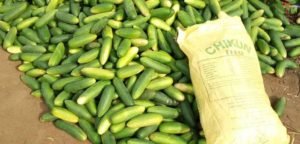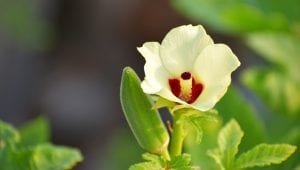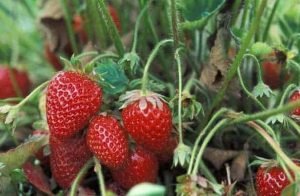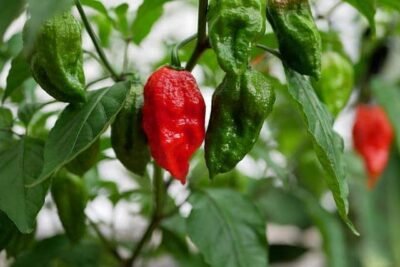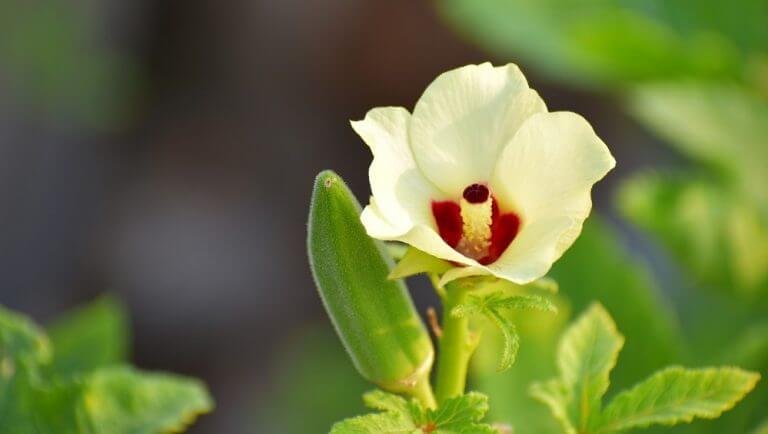How to Grow Bell Peppers From Seeds To Harvest [Complete Beginner Guide]

Whether you are new to gardening or you just want to add bell peppers to your garden, this guide will show you exactly how to grow your bell peppers from seeds to harvest.
You will learn how to plant the bell peppers, care for the plants and apply manure.
Also, you will learn about the different pests and diseases that affect bell peppers and how you can prevent them.
In addition, you will be learning the best tips that expert farmers use to grow bell peppers in their gardens.
There are many more interesting facts about bell peppers that you will find as you read along, but first, let’s talk about bell peppers.
What Are Bell Peppers?
Bell pepper is a hollow green, red, or yellow vegetable with countless seeds clustering in the center.
Bell peppers (Capsicum annuum) are also fruits because they have smooth outer skin and they are fleshy on the inside.
The close relatives of bell peppers include chili peppers, tomatoes, and breadfruit, all of which are native to Central and South America.
Bell peppers are also called sweet peppers or capsicums and they can be eaten either raw or cooked.
Now that we know what bell peppers are, let’s see some of the health benefits of bell peppers to know whether they are worth growing or not.

Health Benefits of Bell Peppers
Bell peppers are rich in many vitamins and antioxidants, especially vitamin C and various carotenoids.
For this reason, they may have several health benefits, such as improved eye health and reduced risk of several chronic diseases.
All in all, bell peppers are an excellent addition to a healthy diet.
For a more detailed explanation, here are some of the benefits of growing and consuming bell peppers.
1. Bell peppers help to improve eye health:
Bell peppers contain over 30 different types of carotenoids including alpha-carotene, beta-carotene, lycopene, lutein, cryptoxanthin, and zeaxanthin.
Carotenoids are a phytonutrient family that is responsible for the bright red, yellow, and orange coloring in many fruits and vegetables.
Researchers have found that they help heal eyes and ward off eye disease because they absorb damaging blue light as it enters the eye.
2. Bell peppers help to prevent cancer:
The carotenoids in bell peppers have powerful antioxidant effects that can prevent certain types of cancers.
They deactivate free radicals, which are the cell-damaging oxygen atoms that react with other molecules in your body.
Ensure that your bell peppers ripen very well so as to increase the antioxidant benefits they possess.
Ripening increases the carotenoid content in bell peppers which provides antioxidant benefits.
Bell peppers also have sulfur which helps prevent cancer.
3. Bell peppers also help to boost immunity:
Bell peppers have more vitamin C when they are ripe.
Therefore, by consuming 1 cup of sliced red bell peppers every day, you get about 157% of your daily vitamin C content.
This makes bell peppers a great fruit that will help you to stay healthy.
4. It helps to balance your mood:
Eating bell peppers helps to balance your mood when you are feeling blue.
The reason is that it produces vitamin B6 which helps your brain produce serotonin and norepinephrine.
These two chemicals affect your mood.
5. Eating Bell peppers helps you sleep better:
If you are unable to fall asleep at night, then eat some bell peppers!
The vitamin B6 found in bell peppers also aids in melatonin production, which your body needs to regulate its internal clock.
6. Consuming bell peppers can help you to lose weight:
Bell peppers are very low in fat and calories.
They contain about 1 gram of fat and 29 calories per cup which makes them an ideal snack option, or a great supplement for your main meal.
This small amount of fat is enough to provide reliable storage for bell pepper’s fat-soluble nutrients.
7. Bell peppers can make your skin look beautiful:
Bell peppers contain a solid amount of Vitamin E, which helps keep skin looking fresh and young, and hair strong and vibrant.
8. It helps to lower bad cholesterol levels:
If you have high cholesterol, then you are in luck if you are growing bell peppers in your garden.
The reason is that bell peppers contain capsanthin which is a nutrient that lowers the levels of bad cholesterol in your system.
9. Consuming bell peppers can help to relieve pain:
Bell peppers contain vitamin C and vitamin K.
These vitamins have anti-inflammatory properties, which reduce swelling and protect against osteoporosis.
Also, the capsanthin in bell peppers helps to relieve chronic pain.
10. Bell peppers protect your heart:
The anti-inflammatory properties of bell peppers help to lower inflammation in arteries.
As a result, it helps to prevent heart disease and diabetes.

Now, let’s go on to learn how to grow bell peppers in pots, gardens, and on a commercial scale.
But before that, let’s see the conditions necessary for growing bell peppers successfully.
Conditions Necessary for Growing Bell Peppers
Growing bell peppers is very easy, however, you need to ensure that all growth factors are appropriate and conducive.
Some of the conditions that must be set right to effectively grow bell peppers include the following;
1. Ensure that the temperature level is optimal:
Bell peppers are warm climate crops, hence they need high temperatures to grow properly.
The warmer the climate, the better the plant will perform.
An ideal temperature for growing bell pepper will fall between 21° – 32°C temperature range.
The best way to achieve this temperature is by exposing the plant to sunlight during the daytime.
2. Select a good soil for growing bell peppers:
The soil is also an important factor to consider when you want to grow bell peppers.
You need to plant the crop in soil that will support its growth.
The best soil for growing bell peppers is well-drained sandy loam soil.
Also, ensure that the pH level of the soil is optimal.
Expert gardeners recommend that using slightly more acidic soil (between 6.0 and 6.8) is the best for growing bell pepper plants to yield a massive harvest.
3. Ensure availability of Water:
Just like every other plant, bell peppers require adequate amounts of water to grow well.
Besides growth, watering the plant will keep them healthy and prevent certain diseases that affect bell peppers.
The best time to water bell peppers is very early in the morning or in the cool of the evening to reduce evaporation.
When to Plant Peppers
People in the tropical regions grow bell peppers as perennial crops because they do well in warm climates.
If you grow bell peppers in colder climates, then you will most likely grow them as annuals because they have no tolerance for cold weather.
Also, they require a fairly long growing season, often up to 90 or even 100 days.
So, it will be great for you to sow your peppers indoors very early in the spring to give them more time to crop throughout summer.
You can start the seeds indoors 8 to 10 weeks before your last spring frost date.
The seeds grow very fast if the temperature is at 25° to 32°C.
To achieve these sorts of temperatures, you’ll need a heated propagator or heat mat.
If the room temperature is lower than this range, the germination may be slower.
As long as you have the ideal temperature conditions, you should see seedlings appear within about two weeks.
However, for some varieties of bell peppers, it may take as long as five weeks, so don’t give up on them too soon!
When they are ready to go outdoors, be sure to harden the young plants off properly to be able to stand the outdoor weather condition.
On the other hand, if you are planting your seeds outdoors, then you need to do so 2 to 3 weeks after the threat of frost has passed in the spring.
The same rule also applies if you are growing from nursery-bought transplants.
Ensure you transplant them outdoors 2 to 3 weeks after the threat of frost has passed in the spring.
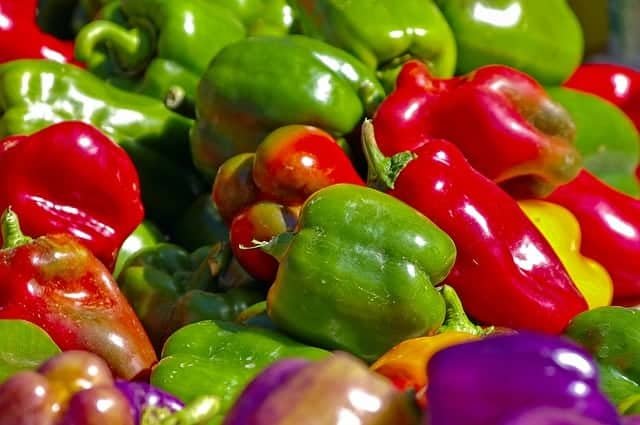
Best bell pepper varieties to plant in your garden – Highly recommended
There are many different types of sweet bell pepper varieties that you can grow in your garden.
And these varieties are readily available on the market today.
Interestingly, you can grow all of them from seeds or as seedlings.
Here are a few bell pepper varieties that you can grow in your garden.
1. Canary bell pepper variety:
This is a slow-growing variety of bell peppers.
It takes about 100 days for Canary bell peppers to reach maturity.
But the long wait will be worth it when you get to enjoy the fruits.
It is tobacco mosaic virus resistant and reaches 3 1/2-by-4-inch in size.
2. Big Red bell pepper variety:
This variety takes about 75 days to harvest and it turns from green to red as it ripens.
It has very thick flesh and tastes sweet when consumed.
3. Coral Bell pepper variety:
The Coral bell pepper variety is another awesome variety to add to your garden.
It has a vibrant orange and grows vigorously.
This variety can produce 4-lobed fruit that reaches about 4-by-3 1/2-inches at maturity.
4. California wonder bell pepper variety:
The California Wonder bell pepper variety is delicious when picked green.
However, you can allow it to ripen on the plant to produce a sweeter red pepper.
This variety is Tobacco Mosaic Virus Resistant and can reach maturity within 75 days.
The fruit grows really big and can reach around 4-by-4 ½-inches max.
5. Purple beauty bell pepper variety:
Purple Beauty is a striking heirloom pepper with a deep purple color.
It has thick-walled flesh and reaches maturity in about 70 days, producing a 4-by-3-inch fruit.
6. The chocolate beauty bell pepper:
The Chocolate Beauty bell peppers have a luscious, deep brown color with super sweet flesh.
This variety grows the quickest, reaching maturity in about 67-70 days.
They are also Tobacco Mosaic Virus resistant.
How to grow bell peppers from seeds
In growing bell peppers from seeds, you can either grow them indoors or outdoors.
You can also germinate the seeds indoors before transferring them outdoors.
Whichever method you choose to use, just make sure that the conditions are right for the plant to grow fine.
How to Start Bell Peppers Indoors
Starting seeds indoors is very important, especially if your climate is not ideal for growing bell peppers.
This will give your bell peppers enough room to germinate properly before transferring to pots or open fields.
Here are the simple steps to follow to grow bell peppers indoors.
1. Choose a good potting mix:
How well your bell peppers will grow depends mostly on the quality of the potting mix that you use.
A good potting mix must be such that drains easily and is full of nutrients to support the plant’s growth.
If you plan to transplant the pepper plants outdoors later on, then you should consider using a soil-based potting mix.
A soil-based potting mix will add extra weight so that containers don’t topple over in the wind.
2. Set the right temperature:
As you already know, bell peppers are heat-loving crops.
The optimal temperature for growing bell peppers is at least 70°F (21°C).
So, ensure that you set the temperature to be just right for the germination of the crop.
3. Plant the seeds in the potting mix:
After placing your potting mix in a position where the temperature is just right for the plant, the next step is to plant the seed.
Place the seeds about 1/4-inch deep into the potting mix and slightly cover them with soil.
If you have doubts, you can also refer to the seed packet for specific instructions.
4. Separate the seedlings out:
If you are planting seedlings, then ensure that you keep the seedlings warm until you’re ready to plant.
Also, separate them out to prevent their root from tangling.
When you are ready to plant them, replant the tall ones up to their lowest leaves.
Doing this will help to provide support for the plant.
5. Provide adequate sunlight:
As much as bell peppers need enough heat, they also need adequate exposure to sunlight.
Plenty of light will encourage healthy, stocky plants that will be less prone to growing top-heavy and flopping over.
You can grow your bell peppers by a window or balcony that receives enough sunlight.
Remember that it has to be somewhere that is both warm and bright.
6. Pot young plants on as the roots fill their pots:
First, your bell pepper seedlings begin at a pot size of around 3 inches, but it won’t take long for them to outgrow this.
Once they develop about five to eight leaves with visible roots, it’s time to move them up a 5-inch pot.
Again, once they’ve filled this, pot them on again in a larger pot of about 8 inches.
The final container size for most pepper plants is around 9 to 12 inches.
Potting on in stages like this ensures plants aren’t ‘lost’ in containers significantly larger than their root balls.
It also means less wasted potting mix should the plants fail at a stage of growth.
7. Leave in pots or transplant the bell pepper plants:
When the plants have hardened enough, you can leave them in the pots or transplant them outside into the garden.
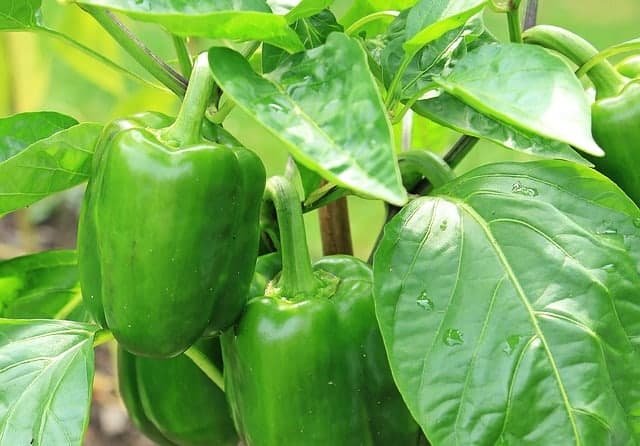
How to Grow Bell Peppers Outdoors Step by Step
Just before your plant your bell peppers outdoors, here are important factors you need to consider in case you missed them earlier.
Also, following these steps will ensure that you get the best out of your bell pepper plants.
- First, ensure that you pick a site that allows enough sunlight to hit the plant. Avoid all kinds of shades on the plant and you will produce the largest and healthiest bell peppers.
- Secondly, remember to plant in a well drained-soil that is rich in organic matter. If the soil is too wet, it will affect the plant’s performance.
The best soil for bell pepper plants is sandy loam soil that drains quickly.
- The soil should be slightly acidic with a pH range of 6.0 – 7.0.
- About a week or two before transplanting the peppers into the garden, introduce or aged compost into your garden soil. Alternatively, cultivate a slow-release fertilizer into the soil.
- Before transplanting the bell peppers outdoors, first harden the plants for about 10 days.
- Plant the bell pepper seedlings when the soil is 60°F (16°C) with a plant spacing of 18 – 24 inches apart.
- The transplants should not no deeper than they were already otherwise, the stems may become more susceptible to rot.
- Finally, do not plant bell peppers in places where you’ve recently grown plants like potatoes, eggplants or tomatoes.
Doing this may expose the plant to diseases that may reduce your yields.
How to Harvest Bell Peppers
Once the plants begin producing fruits, pick them promptly, the moment they have reached their full size and color.
Regular picking encourages plants to produce more flowers and, of course, more fruits.
That said, the longer bell peppers stay on the plant, the sweeter they become and the greater their vitamin C content.
Use a sharp knife or scissors to cut peppers clean off the plant.
How to Store Bell Peppers
Bell Peppers can be refrigerated in plastic bags for up to 10 days after harvesting.
Gluts of bell peppers can be dried whole in a dehydrator or any warm place with good airflow.
Here are directions on how to dry peppers for storage:
- Wash, core, and seed the peppers. Cut into one-half-inch strips. Steam for about ten minutes, then spread on a baking sheet.
- Dry in the oven at 140°F (or the lowest possible temperature) until brittle, stirring occasionally and switching tray positions.
- When the peppers are cool, put them in bags or storage containers or airtight jars.
- Or, chop peppers up for packing into ice-cube trays.
- Freeze them then pop them out into freezer bags ready for dropping into recipes as needed.

7 Bell Pepper Plant Care Tips
Generally, here are the tips you need to be aware of when growing bell peppers.
1. Bell peppers prefer rich soil that’s more sandy or loamy, which keeps your ground conditions well-drained and warm. Bell peppers also like a soil pH between 6.0 and 6.8. To give your bell pepper plants the proper care they need:
1. Mulch the plants properly to retain heat and reduce weeds:
Black plastic mulch can help absorb the sun and keep your ground soil warm.
Grass clippings are also good for bell peppers, as they can help smother weeds that could damage their delicate root system.
2. Water the plants properly but do not waterlog the soil:
Bell peppers need a deep watering, about one to two inches per week.
Although bell peppers like warm weather, they will not flourish in intense heat, so gardeners in climates that are prone to higher temperatures should water twice a day if necessary.
Dry conditions will cause bitter-tasting peppers, but overwatering can suffocate the roots or lead to blossom end rot, which happens if the calcium in the soil is depleted.
Monitor your watering carefully, keeping it as balanced as possible.
3. Provide enough sunlight.
Bell peppers need full sun to grow and ripen properly.
So, keep them in a sunny spot in your vegetable garden.
The only exception is if you live in a climate susceptible to extremely high heat and intense sunlight.
In that case, shade cloth or nearby plants can be used to manage temperatures.
4. Use the right fertilizer:
Fertilize with a compound that’s low in nitrogen to help your bell peppers grow without affecting the rate of fruit production.
5. Support the plants with stakes:
While not a necessity, staking your bell peppers can help keep them off the ground, away from pests.
It can also help reduce sunscald, which can occur if the pepper is exposed to direct sunlight for too long under high temperatures.
Bell pepper leaves usually provide somewhat of a canopy for the fruit, and staking can help keep them upright and protected.
6. Check for pest infestation:
Aphids and flea beetles are two garden pests that love bell peppers.
Use organic insecticides and tend to your plant often to keep pest invasions under control.
7. Plant along with companion plant:
Bell peppers do well around corn, cucumbers, and carrots, but won’t thrive near cabbage family plants or fennel.
8. Weed carefully around plants to avoid disturbing roots:
When it is time to weed your bell pepper plants, make sure that you weed the crops properly.
Doing it carelessly can affect the plant’s root which could kill the plant.
Bell Pepper Pests and Diseases Insect Pests
1. Broad Mites:
Broad mites, which are a major pepper pest, can be found underneath undeveloped, growing foliage.
These eight-legged pests feed on the plant, destroying its tissue and causing leaves to thicken and narrow.
When feeding heavily, these tiny, white mites can also kill flowers and russet fruit.
Unlike other pests, there are currently no scouting options available to manage broad mites.
However, general mite predators can control pests, and timely chemical control—using specific acaricides rather than broad-spectrum insecticides—can destroy the broad mites.
2. Leafminers:
As adults, leafminers are small flies that puncture the upper leaf’s surface to feed or lay eggs.
The yellow and black larvae eat on the leaf surface, leaving a twisting mine that reduces photosynthetic area and creates entrance points for pathogens.
While scouting the fields for leafminers can be useful, parasitic wasps can serve as a natural enemy and kill many leafminers.
In addition, several insecticides are designed to affect these pest populations.
3. Melon Thrips:
These dark yellow pests, which are often found in flowers, are primarily limited to southern Florida.
Both the adults and larvae suck the plant’s outermost layer and cause “flecking.”
Monitor plants for adult and larvae, and only treat when you see more than two larvae per small fruit or six adults per flower.
Rather than using pesticides, natural enemies, such as minute pirate bugs, and ultra-violet reflective mulches can control these pests.
4. Pepper Weevils:
While adults feed on leaf or flower buds, the females also bore small holes in emerging fruit and lay eggs.
These larvae, which are legless grubs, eat to the fruit’s core, feeding on seeds and pulp.
The infected fruit then rots and falls from the plant.
Pheromone traps and searching for adults during the morning hours can help find and control pepper weevils early.
Because only the adult weevil is susceptible to insecticides, it’s best to remove and destroy all infected or damaged fruit, avoid planting nearby, and deep-plow crops right after harvest.
5. Aphids:
This may cause leaves to yellow and/or distorted.
It also causes the plants to develop necrotic spots on leaves and/or stunted shoots.
Aphids secrete a sticky, sugary substance called honeydew which encourages the growth of sooty mold on the plants.
If the aphid population is limited to just a few leaves or shoots then the infestation can be pruned out to provide control.
Before transplanting your bell pepper plants, ensure that you check transplants for aphids before planting.
You can plant tolerant varieties of bell peppers if available.
You can also use reflective mulches such as silver-colored plastic that can deter aphids from feeding on plants.
If the plants are sturdy enough, then you can spray with a strong jet of water to knock aphids from leaves.
Only use Insecticides to treat aphids if the infestation is very high.
The reason is that plants generally tolerate low and medium-level infestation.
Using insecticidal soaps or oils such as neem or canola oil is usually the best method of controlling aphids.
Always check the labels of the products for specific usage guidelines prior to use.
6. Tomato Worm:
This burrows into fruit near stem end and feeds on fruit interior causing decay.
As a result, fruits turn red prematurely and fall from plants which reduce potential yield.
To prevent this from destroying your farm, it is important to detect early and begin treatments immediately.
The reason is that once they enter the fruit, it will be difficult for sprays to get to them.
You can apply Bacillus thuringiensis or Entrust SC to control insects on organically grown plants.
Either way, you may require an appropriate chemical treatment to control tomato worms in commercial bell pepper plantations.
Reference
- 10 Pro Tips on How to Take Care of Succulents
- 6 Uses For IBC Totes On The Farm
- Revolutionizing African Agriculture: The Potential of Bokashi Composting
- Cucumber Farming: How to Plant, Grow, and Harvest Cucumbers
- Okra Cultivation Guide – The Step-By-Step Okra Farming Procedure
- Cucumber Companion Planting [The best and the worst crop to grow with cucumber]



